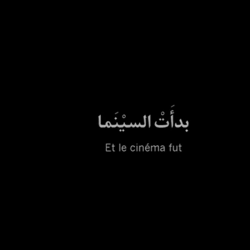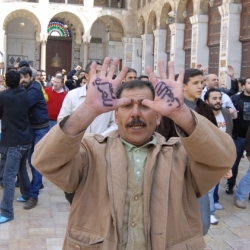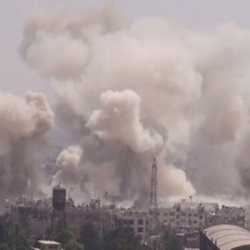The image of the oppressor and the image of the victim in war
02/04/2015
Author: Roy Dib
Since the start of the Syrian revolution, debate has raged over the importance of the image, its potency and the different ways by which one can engage with it. In this article, we attempt to participate in this debate from a different angle: dealing with the power of the image, its aims, its audience and the ease (or difficulty) of accessing it, by reference to what is technically known as “hors champ” or “out of frame”—a concept that incorporates both the problem at hand and a means to solve it.
The power of the image
History tells us, unfortunately, that in wartime the image is powerful in the hands of a powerful oppressor and weak in the hands of a weak victim, regardless if the image is real or fabricated.
If we take the image in the Palestinian-Israeli conflict as an example, this fact is clearly evident. From the nakba up to the present day, all types of images of the Palestinian issue have been taken, from the gory to the blood-free. For instance, the image of the child Mohamad Al Durra and his father from the second Intifada in Al Aqsa is regarded as one of the most powerful photographs taken in recent decades. The image shook world opinion and pushed it to take action. But then what happened? Did the injustice stop?
No. In fact the murder of Palestinians increased as did the occupation of territory and the construction of settlements. The same thing took place during the latest Israeli aggression in Gaza, when images that showed the world the horror of the destruction inflicted by Israel helped prompt demonstrations in a number of cities around the world, decrying the assault. Today, with the assault now over, have these demonstrations led to Israeli crimes being prosecuted in the international courts, or even an easing of the inhumane conditions in Gaza? No.
Did Israel meet its objectives during the aggression?
Many of them, Yes.
On the other side, Israel has produced less images over the span of the conflict, but sufficient enough to convince Israelis and the world that it is defending its rights. Is this because the images Israel produced were more powerful than those made by the Palestinians? Of course not. It’s simply because Israel is more powerful than Palestine. Then again, in recent decades, the United States has released fabricated images from Iraq, managing to justify its attack on the country. Did objecting to these images get anyone anywhere? No!
Even images of the Jewish holocaust in Europe did not help their cause during the Second World War. Rather, the Zionist lobby had to become powerful before it was able—subsequently—to exploit these images for other ends, right up to the present day. The same is true of the majority of famous images of war throughout history. The images became famous, became icons of these wars, but only after the wars were over. As for the decision to start and end wars, the image of the victim has never had a say in such matters: the decision rests on economic and political motivations and interests completely divorced from concepts of supporting the oppressed or achieving justice.
The aim, the audience, accessibility
The oppressor's task is an easy one. His image has a clear aim, its audience is clearly defined and it is readily available. Through his image, the oppressor aims to prove his strength and inspire terror in his opponent. The audience is the opponent, whether it be the revolutionary Syrian population, the Free Army, or even the fundamentalist Islamic brigades who fight among themselves. Whatever the case, whenever the oppressor wants to deploy images he has produced his target audience is clear and he knows just where to find them. Then again, it is extremely easy for the oppressor to take his images: a beheading, burning a man alive, hitting a target, setting up an ambush, destroying a building—carefully framed images designed to highlight a single cohesive event. These are the oppressor’s images. This is why it is so easy, with sophisticated equipment at their disposal, for the oppressors to produce such sophisticated images. It is this skill, this artistry, which enables them to inflate the action and the impact it has on the viewer. This is what we have witnessed—and continue to witness—in images produced by the Assad regime, Al-Nusra and the Islamic State. In these instances, the oppressor has no need to prove a thing. He only takes his image to inform the world that he is powerful. Through the image he declares his victory and spreads terror.
Meanwhile, the victim’s task is very difficult. Although his aim is clear, his audience is ill-defined and hard to reach, because in times of war the victim records images to prove to the world that he is exposed to murder, bombardment and torture—he records to prove that he is the victim, that he needs help to end the injustice he suffers. His audience is what is known as “world opinion”, which in turn must pressure decision-makers into participating in the relief of the victim’s injustice. We all know that this role is immensely complex and requires intensive and combined efforts to ensure that the victim’s interests correlate with those of the decision-makers of the major powers before the latter will intervene to save the former. As for the actual taking of the images, how can the victim encapsulate torture, destruction and death in a photograph or two? Or even a thousand? How many deaths and massacres does the victim require to prove to world opinion that he’s a victim? How wide must he frame the shot for it to hold the full horror of the catastrophe?
Even as the oppressor’s image—amplified and sophisticated—hits its marks, the victim’s image remains weak, overburdened and incapable of achieving all it sets out to do. Furthermore, the victim is often the consumer of images produced by the oppressor and shares them through the media, thus widening their viewership, while the oppressor does not engage with the victim’s images, whose audience remains limited in scope. If the oppressor’s images of war are more powerful, even when fabricated, the victim’s images are weak no matter how faithful to the truth they are.
If the above analysis of the aims, audience and accessibility of the images of oppressor and victim shows the oppressor at an advantage, does this mean the victim should stop taking images? Of course not, but there is an urgent need to take a different approach to the victim’s images.
The image as documentation
At this juncture, and in the context of this discussion, a distinction should be drawn between the image in wartime and the post-war image. There can be no dispute that the victim’s image, even when it fails to achieve a single one of its aims during wartime, remains highly important as a document of the oppressor’s criminality, and to the writing of a history that may one day champion the victim and condemn the oppressor. “Fortunately”—so to speak—the immediate enemy of the Syrian revolutionary population (the victim) is not Israel or the United States but rather the Assad regime and the fundamentalist Islamic brigades, which means no serious obstacles exist to their being tried one day in the international courts. The image will be a fundamental piece of evidence used against them, without the preemptive right of veto being deployed as we have been used to seeing in cases involving the USA and Israel. The international criminal courts have tried cases involving many important conflicts, including Yugoslavia, Rwanda, Northern Uganda, the Democratic Republic of Congo, the Central Africa Republic, and Darfur—but only once the war is over when the image comes to possess a documentary power before the courts. The image must be engaged with in a different way, and then maybe it can benefit the victim in the present.
Out of shot: between problem and solution
The problem
Any photographer, professional or amateur, is, in the moment they take their shot, choosing what they do not want in the image (i.e. the “hors champ”) just as much as they are selecting what they wish to include. The photographic process involves defining the subject matter that is to be placed within the frame of the image and separating it from what lies outside this frame. Indisputably, what lies outside the frame is bigger and more extensive that what the frame contains, and thus the truth outside the frame is commensurately larger and more extensive than what lies within it.
In other words, whenever we take a shot we are deliberately breaking up the truth: selecting a small piece of it. This is the “hors champ” problematic, one that the oppressor does not face because his aim is to foreground a single act, confined within the frame of his image. The victim, on the other hand, chooses the subject matter to be contained within the frame because he is forced to choose, yet he is fully aware of the presence of the “hors champ”, that this space outside the frame contains subject matter and information that he wouldn’t hesitate to include if he could—but despite himself he chooses to break up the truth and confine it to the single detail within the frame. This is the fundamental problem that confronts the victim: there is no frame capable of encompassing the full horror of the catastrophe should he take a shot of that destroyed house and ignore all the other buildings? Should he snap that body over there and ignore all the other corpses? In this way, the concept of “hors champ” constitutes a crisis for the victim while failing to cause the oppressor much concern.
The solution
The practical solution lies in compensating for the inadequacy inherent in the “hors champ” problematic. The oppressor aims to highlight what lies within the image, because everything that lies out of shot exposes his fabrication. Taking one part of the truth and confining within the frame of the image, isolating it from its content, is a strategy that suits the oppressor and harms the victim. The reverse can also apply.
The victim must therefore do two things:
First, he must compensate for the inadequacy of the image by replacing the “hors champ” with some other material. This may involve providing a textual account to complete the narrative, for example. In Edward Said’s reading of the failure of Palestinians and Arabs in their conflict with Israel, he asserts that one of the basic reasons for this failure lay in their inability to unify their narrative when confronting Israel, while the Zionist lobby was able to convince the world that Palestine was the promised land of the Jews. For this reason, the victim cannot simply provide fragmented images of the world, but rather, each image must be presented alongside a narrative that places the image within a clear context that forms part of the overarching truth. The victim must not forget that he possesses the true narrative that the oppressor seeks to distort this truth to justify the injustice he perpetrates. Therefore the victim must unify the narrative and support his image with an “hors champ” of a different kind. This might be through a textual narrative—as proposed here—or any other material that can deliver the truth in its “entirety”.
Second, if the oppressor’s goal is to isolate the image from the “hors champ” then the victim’s must be to expose it. The oppressor does not want us to see what lies outside the frame of the image he has selected for us, because outside that frame is what condemns him. Instead of engaging with and sharing the oppressor’s images in the belief that they expose him (whereas they merely increase his audience) the victim must work to expose what the oppressor wishes to hide. This “hors champ” is what reveals his fraud and false narrative.
Does this relationship with the “hors champ” really offer a solution; can it truly bring a halt to the injustice that the victim suffers in time of war? Unfortunately, and as we mentioned at the outset, the image will never be able to bring an end to war. The image will remain powerful in the hand of the powerful oppressor and weak in the hand of the weak victim. However, if the victim’s image can prompt a move towards a complete narrative, or truth, and if the victim can expose the fraudulence of the oppressor’s image then the impact he has on world opinion might be broadened, pressure on decision makers increased and the process of securing a solution sped up.
















